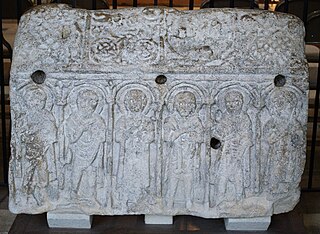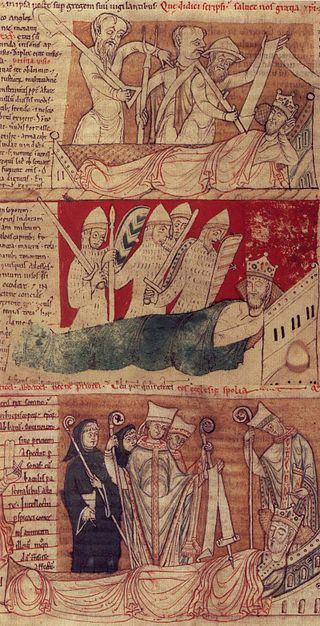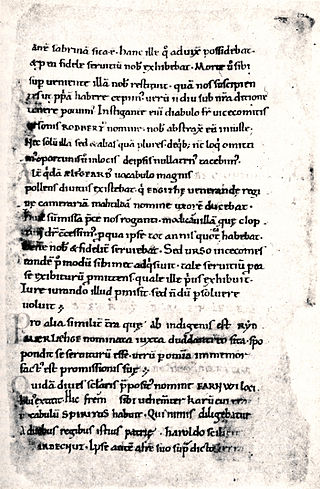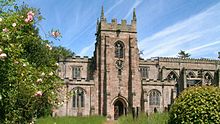
Justus was the fourth Archbishop of Canterbury. He was sent from Italy to England by Pope Gregory the Great, on a mission to Christianize the Anglo-Saxons from their native paganism, probably arriving with the second group of missionaries despatched in 601. Justus became the first Bishop of Rochester in 604, and attended a church council in Paris in 614.
Saint Mellitus was the first bishop of London in the Saxon period, the third Archbishop of Canterbury, and a member of the Gregorian mission sent to England to convert the Anglo-Saxons from their native paganism to Christianity. He arrived in 601 AD with a group of clergy sent to augment the mission, and was consecrated as Bishop of London in 604. Mellitus was the recipient of a famous letter from Pope Gregory I known as the Epistola ad Mellitum, preserved in a later work by the medieval chronicler Bede, which suggested the conversion of the Anglo-Saxons be undertaken gradually, integrating pagan rituals and customs. In 610, Mellitus returned to Italy to attend a council of bishops, and returned to England bearing papal letters to some of the missionaries.
Old English literature refers to poetry and prose written in Old English in early medieval England, from the 7th century to the decades after the Norman Conquest of 1066, a period often termed Anglo-Saxon England. The 7th-century work Cædmon's Hymn is often considered as the oldest surviving poem in English, as it appears in an 8th-century copy of Bede's text, the Ecclesiastical History of the English People. Poetry written in the mid 12th century represents some of the latest post-Norman examples of Old English. Adherence to the grammatical rules of Old English is largely inconsistent in 12th-century work, and by the 13th century the grammar and syntax of Old English had almost completely deteriorated, giving way to the much larger Middle English corpus of literature.

Edward, often called the Martyr, was King of the English from 975 until he was murdered in 978. Edward was the eldest son of King Edgar, but was not his father's acknowledged heir. On Edgar's death, the leadership of England was contested, with some supporting Edward's claim to be king and others supporting his younger half-brother Æthelred, recognised as a legitimate son of Edgar. Edward was chosen as king and was crowned by his main clerical supporters, the archbishops Dunstan of Canterbury and Oswald of York.

Edmund the Martyr was king of East Anglia from about 855 until his death.

Oda, called the Good or the Severe, was a 10th-century Archbishop of Canterbury in England. The son of a Danish invader, Oda became Bishop of Ramsbury before 928. A number of stories were told about his actions both prior to becoming and while a bishop, but few of these incidents are recorded in contemporary accounts. After being named to Canterbury in 941, Oda was instrumental in crafting royal legislation as well as involved in providing rules for his clergy. Oda was also involved in the efforts to reform religious life in England. He died in 958 and legendary tales afterwards were ascribed to him. Later he came to be regarded as a saint, and a hagiography was written in the late 11th or early 12th century.

Deusdedit was a medieval Archbishop of Canterbury, the first native-born holder of the see of Canterbury. By birth an Anglo-Saxon, he became archbishop in 655 and held the office for more than nine years until his death, probably from plague. Deusdedit's successor as archbishop was one of his priests at Canterbury. There is some controversy over the exact date of Deusdedit's death, owing to discrepancies in the medieval written work that records his life. Little is known about his episcopate, but he was considered to be a saint after his demise. A saint's life was written after his relics were moved from their original burial place in 1091.
Nothhelm was a medieval Anglo-Saxon Archbishop of Canterbury. A correspondent of both Bede and Boniface, it was Nothhelm who gathered materials from Canterbury for Bede's historical works. After his appointment to the archbishopric in 735, he attended to ecclesiastical matters, including holding church councils. Although later antiquaries felt that Nothhelm was the author of a number of works, later research has shown them to be authored by others. After his death he was considered a saint.

Medeshamstede was the name of Peterborough in the Anglo-Saxon period. It was the site of a monastery founded around the middle of the 7th century, which was an important feature in the kingdom of Mercia from the outset. Little is known of its founder and first abbot, Sexwulf, though he was himself an important figure, and later became bishop of Mercia. Medeshamstede soon acquired a string of daughter churches, and was a centre for an Anglo-Saxon sculptural style.

John of Worcester was an English monk and chronicler who worked at Worcester Priory. He is usually held to be the author of the Chronicon ex chronicis.

Norbury is a village in Derbyshire, England. It is located 3 miles (4.8 km) north of Rocester, on the B5033 road and the River Dove. The hamlet has links with George Eliot's family, the Evans. George Eliot's father, Robert Evans, was born in Roston Common and sang in the choir at Norbury church, and most of George Eliot's paternal ancestors are buried there.

Sir Ralph Fitzherbert was Lord of the manor of Norbury, Derbyshire. His effigy in his suit of armour at Norbury church are reproduced in the Victoria and Albert Museum, in contemporary armour.

Hemming's Cartulary is a manuscript cartulary, or collection of charters and other land records, collected by a monk named Hemming around the time of the Norman Conquest of England. The manuscript comprises two separate cartularies that were made at different times and later bound together; it is in the British Library as MS Cotton Tiberius A xiii. The first was composed at the end of the 10th or beginning of the 11th century. The second section was compiled by Hemming and was written around the end of the 11th or the beginning of the 12th century. The first section, traditionally titled the Liber Wigorniensis, is a collection of Anglo-Saxon charters and other land records, most of which are organized geographically. The second section, Hemming's Cartulary proper, combines charters and other land records with a narrative of deprivation of property owned by the church of Worcester.

The Anglo-Saxon Chronicle is a collection of annals in Old English, chronicling the history of the Anglo-Saxons. The original manuscript of the Chronicle was created late in the 9th century, probably in Wessex, during the reign of Alfred the Great. Multiple copies were made of that one original and then distributed to monasteries across England, where they were independently updated. In one case, the Chronicle was still being actively updated in 1154.
The Gesta Pontificum Anglorum, originally known as De Gestis Pontificum Anglorum and sometimes anglicized as The History or The Chronicle of the English Bishops, is an ecclesiastical history of England written by William of Malmesbury in the early 12th century. It covers the period from the arrival of St Augustine in AD 597 until the time it was written. Work on it was begun before Matilda's death in 1118 and the first version of the work was completed in about 1125. William drew upon extensive research, first-hand experience and a number of sources to produce the work. It is unusual for a medieval work of history, even compared to William's other works, in that its contents are so logically structured. The History of the English Bishops is one of the most important sources regarding the ecclesiastical history of England for the period after the death of Bede.
Hatton Gospels is the name now given to a manuscript produced in the late 12th century or early 13th century. It contains a translation of the four gospels into the West Saxon dialect of Old English. It is a nearly complete gospel book, missing only a small part of the Gospel of Luke. It is now in the Bodleian Library, Oxford, as MS Hatton 38.
On the Resting-Places of the Saints is a heading given to two early medieval pieces of writing, also known as Þá hálgan and the Secgan, which exist in various manuscript forms in both Old English and Latin, the earliest surviving manuscripts of which date to the mid-11th century. Secgan is so named from its Old English incipit, Secgan be þam Godes sanctum þe on Engla lande aerost reston "Tale of God's saints who first rested in England"), and is a list of fifty places which had shrines and remains of Anglo-Saxon saints. Þá hálgan is a version of the so-called Kentish Royal Legend is a heading which appears to be for both texts, as the Kentish legend, which comes first, is actually an account of how various members of the royal family of Kent, descendants of Æthelberht of Kent, founded monasteries and came to be regarded as saints. As such it is closer to other hagiographical texts than to the list of burial sites that follows it. The texts describe people living from the 7th to 10th centuries, and they exist in both Old English and Latin versions, but both have their earliest known manuscripts dating from the 11th century.
Æthelwine of Sceldeforde was a seventh century saint, venerated in the Roman Catholic and Eastern Orthodox churches, who lived in Anglo-Saxon England. He is known to history from records in the hagiography of the Secgan Manuscript. He was venerated as a saint after his death, though some question his historical authenticity.

Beornstan the Archdeacon, also known as Byrnstan, was a medieval Catholic saint from Kent in Anglo-Saxon England.

St Mary and St Barlock's Church, Norbury is a Grade I listed parish church in the Church of England in Norbury, Derbyshire.












